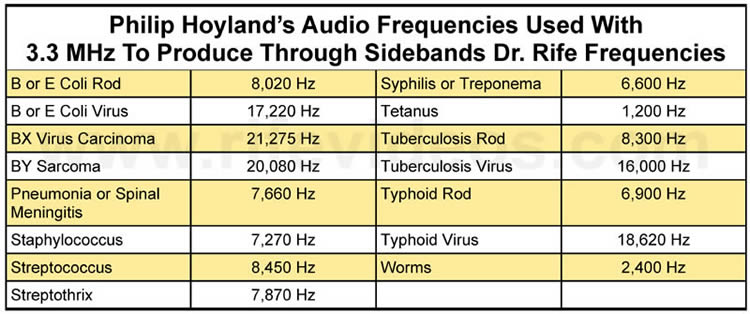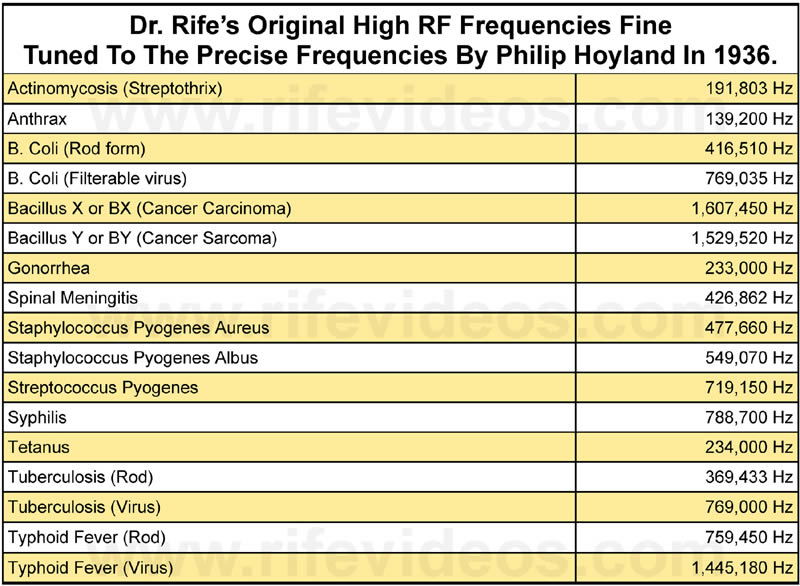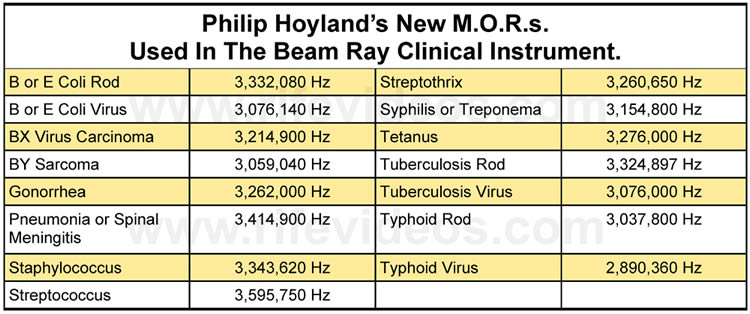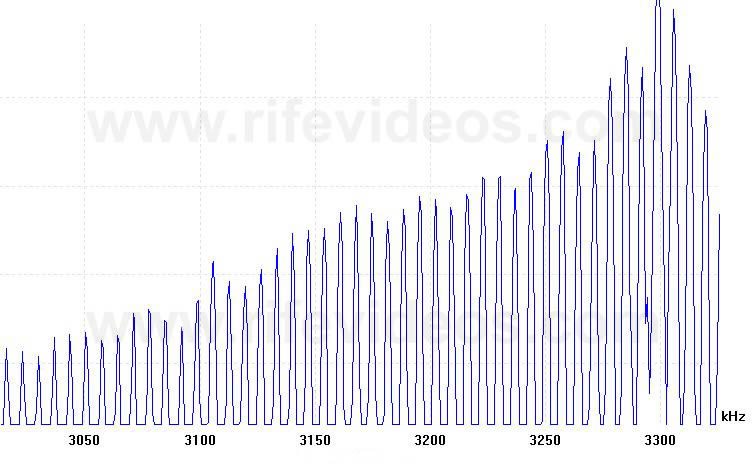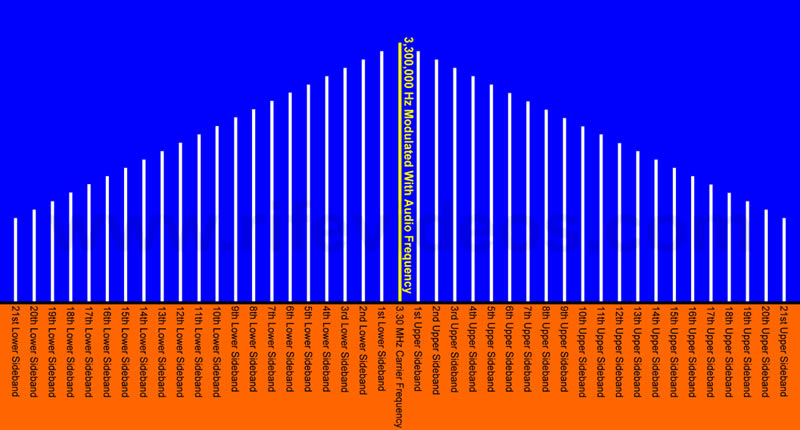| Home | Accessory Kit | Marsh CD Collection | Library | Contact Us |
Dr. Royal Raymond Rife |
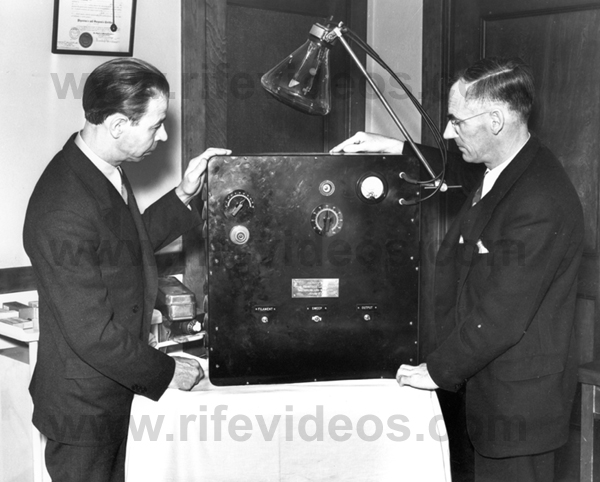 |
Dr. Rife and Philip Hoyland's |
If you have already read Chapter 9 and Chapter 11 of "The Rife Machine Report" on this site, this sweep method will be easier to understand. If you have not read those chapters then we suggest that you read those chapters so that you can understand how the original Beam Ray Clinical instrument (M.O.P.A. or Master Oscillator Power Amplifier) worked. You also may want to read "Dr. Rife's true original frequencies" page also. COMPARET: Now what [Dr] Couche did, see, he would have cases where he would get an instantaneous cure, like that, and other times when the treatment just didn’t produce any results, because of the frequency shift. So, he would start in, he had from Rife (They were Hoylands dial settings that produced harmonic frequencies from Dr. Rife's original frequencies that would devitalize the organisms) a set of the frequencies for several different diseases and he would tune it deliberately to one side of that frequency and then gradually tune it across to the other side making sure that somewhere in the process he crossed the correct frequency, even if the instrument wasn’t exactly in tune anyway. Well, when they hit the exact frequency they got amazing results.” (1970's Bertrand Comparet interview #10) Because these doctors had to sweep the dial for each frequency they used it became obvious that a sweep of the full range of the frequencies which they used would really be the best way to use this type of equipment. Therefore the credit for this sweep is given to Dr. Rife and Philip Hoyland. When Dr. Milbank Johnson M.D. and Philip Hoyland were testing the first proto-type of the Rife Ray #5 or Beam Ray Clinical instrument they had something happen which amazed everyone that was working in Dr. Johnson's Laboratory. It was this event that revealed the full capability of the Beam Ray Clinical instrument and the possibilities of what a sweep with this M.O.P.A. type instrument could do. Below is Dr. Johnson's letter which describes what happened: DR. JOHNSON: “Last summer, in hunting for the M.O.R. for the other two reproductive forms of the cryptomyces pleomorphia, we ran into a new band of oscillations which introduced itself to us by killing all three forms - those that we called BX, our filter-passing form; then a transitional form such as you found in the monocytes in the blood; and then the third or highly developed form coming from the sporangius forming from the hyphas of the mycelium. At the same time that this new wave band arrived, we broke all the glass in the laboratory of a certain shape, not only in the room where we were working but in all the other rooms...we had been troubled a great deal with a mold because in the microscope room there were no windows, but this band not only destroyed that mold, which was growing on the leather objects in the room, but every bacteriological culture that we had in the laboratory! It cleaned us out completely so we had to start from scratch and replace our losses. In fact, we were all so surprised that we began to feel each other’s pulses to see if we were still alive. As no harm had been done to us, we proceeded to test the new band out on mice, rats, rabbits, guinea pigs and dogs. So far as we were able to discover, it is not at all destructive or injurious to normal cell tissue. While we have been forced to modify our machine so as to produce this new band, still it is so much more effective clinically that we look upon it as a very advantageous discovery. However, our experience has forced us to do all of our experimenting with the new ray [Rife Ray #5 or Beam Ray Clinical instrument] completely outside of our laboratory building or abandon all form of bacteriological experiments, because it instantly kills them all. I can assure you that no one, not even myself, could help but be astounded at the results we are now obtaining with the assistance of our new machines and our new band of MOR's." (Letter from Dr. Johnson to Dr. Gruner (copy sent to Dr. Rife) dated, November 4, 1936. Page 1, Page 2). From this letter, we learn that Dr. Johnson and Philip Hoyland were looking for the frequencies for two organisms that were connected to cancer. In order for them to find these frequencies, it was necessary for them to sweep the dial of the instrument through the various frequencies. The proto-type of this instrument apparently malfunctioned which gave them a new band of frequencies (audio frequencies) to work with. While sweeping through this new band of frequencies they happened to be able to kill these two organisms. Not only were they able to kill these two organisms but they were also able to kill all of the organisms in the laboratory including the mold on the walls and furniture. This effect totally amazed them. They made the modifications to the Beam Ray Clinical instrument so that this new band of frequencies would be included in it. They also found that this Beam Ray Clinical instrument could not be used in the laboratory because every time they used it they would kill all the microorganisms in the laboratory. None of Dr. Rife's previous instruments ever had the capability that this instrument had. Even though this new Rife Ray #5 or Beam Ray Clinical instrument was useless in the laboratory for finding individual frequencies for organisms, it was ideal for using clinically. Dr. Johnson pointed this fact out in his letter. The major difference between this new Beam Ray Clinical instrument and Dr. Rife’s previous instruments is the fact that this new instrument could produce over one hundred harmonic side bands simultaneously. It was this new harmonic sideband capability in this Beam Ray Clinical instrument which makes this sweep we are discussing on this page possible. We will now explain the significance of this 3.30 MHz (Megahertz) sweep and how it can be used to produce all of Dr. Rife’s frequencies, both known and unknown. Not only can it be used to produce Dr. Rife’s frequencies, both known and unknown, but this sweep can produce the frequencies for many organisms that we do not have the frequencies for. This makes this sweep very advantageous to use. Almost all of Dr. Rife’s frequencies that he found which would devitalize the various micro-organisms ranged from 139,200 Hertz to 1,607,450 Hertz. Philip Hoyland found with his Beam Ray Clinical instrument that he could cover this entire frequency range using a fixed 3.30 Megahertz (MHz) carrier frequency modulated (combined) with audio frequencies. Through the use of these audio frequencies which were modulated onto this 3.30 MHz carrier frequency, high-frequency harmonic sidebands were created. The audio frequencies used in this instrument ranged from 1,200 Hertz to 21,275 Hertz. In the chart below we see the audio frequencies that are used with 3.30 MHz to produce, through harmonic sidebands, all of Dr. Rife's known high RF frequencies.
Philip Hoyland was able to produce all of Dr. Rife's frequencies, through harmonic sideband frequencies, using these audio frequencies because he found that Dr. Rife was correct when he said that many of his frequencies were harmonics (actually Dr. Rife meant sub-harmonics of higher frequencies). When Philip Hoyland tested this concept out in the laboratory in the summer of 1936 with Dr. Milbank Johnson, M.D., he found that Dr. Rife was correct that his frequencies were sub-harmonics of higher frequencies. These higher RF harmonic sideband frequencies were the frequencies that Philip Hoyland used to kill or devitalize the microorganisms he tested. To show how this works we will use the first frequency in the chart shown below for our example.
By verifying what Dr. Rife already understood Philip Hoyland discovered that he could take the M.O.R. frequency that Dr. Rife found for Streptothrix, which was 191,803, and multiply it by 17 (17 X 191,803 = 3,260,651 Hertz) and use that frequency to devitalize the Streptothrix organism. What Philip Hoyland did was verify and prove that every harmonic of Dr. Rife’s frequencies can be used to devitalize the organisms. Philip Hoyland multiplied every one of Dr. Rife’s frequencies up in the frequency range so that they would all be as close as he could get them to 3.30 Megahertz (3,300,000 Hertz). By doing this he could use audio frequencies from 1,200 Hertz to 21,275 Hertz to produce, through the harmonic sideband method, all of Dr. Rife’s frequencies. Below is a chart of the new higher harmonic M.O.R. frequencies that were used in the Beam Ray Clinical instrument. These are the frequencies that Dr. Johnson was making reference to in his letter when he said: DR. JOHNSON: "with the assistance of our new machines and our new band of MOR's."
What this information reveals is that every frequency of any organism that ranges from about 40,000 Hertz to 1,800,000 Hertz (1.8 MHz) could be multiplied up so that it would be within the range of this 3.30 Megahertz sweep. Now with this understanding, if a sweep was done with a Beam Ray Clinical instrument from 25,000 Hertz down to 500 Hertz using a 3.30 MHz carrier frequency it would hit every one of Dr. Rife’s frequencies for the various micro-organisms. This sweep would also hit the frequency of any organism that was between about 40,000 Hertz to 1,800,000 Hertz. Since we know that the smallest of these organisms was the B.X cancer virus and it had the highest frequency (1,607,450 Hertz), it is reasonable to assume that all the rest of these organisms’ frequencies would be covered in this sweep. Also, there are many organisms’ frequencies that have never been discovered but if they are somewhere between about 40,000 Hertz and 1.8 MHz (1,800,000 Hertz) then this sweep would also cover those frequencies.
Now to show how Philip Hoyland's harmonic sideband circuit worked we will take the B.X. cancer virus audio frequency of 21,275 Hertz which was used in the Rife Ray #5 or Beam Ray Clinical instrument. The 4th sideband hits the frequency of 3,214,900 Hertz (Dr. Rife's original BX frequency of 1,607,450 Hertz multiplied by 2 = 3,214,900 Hertz). This 3,214,900 Hertz frequency was the new primary frequency used by Philip Hoyland for the B.X cancer virus with the Beam Ray Clinical Rife machine. The 5th sideband will hit the B.X. frequency of 3,214,900 Hertz at the audio frequency of 17,020 Hertz. The 6th sideband will hit the B.X. frequency of 3,214,000 Hertz at the audio frequency of 14,183 Hertz. Just from this one example, it is easy to see that every organism's frequency is hit many times as this sweep goes from 25,000 Hertz down to 500 Hertz. This is the reason that this instrument was able to kill all the organisms in Dr. Johnson's laboratory. This is also the reason that they could never use this instrument in a laboratory setting. This instrument was only used by doctors in their private practices. If you look at the sideband chart shown below you can see many of these harmonic sideband frequencies which are created when a single audio frequency is modulated onto a 3.30 MHz carrier frequency. As the frequency sweeps from 25,000 Hertz down 500 Hertz the space between the sidebands gets narrower. Not only are these sideband frequencies narrowing, or getting closer together, they are also moving in closer towards the carrier frequency of 3,300,000 Hertz (3.30 MHz). This is why every frequency is hit many times by different harmonic sidebands. Anyone understanding this sweep can see how using this method with an original Beam Ray Clinical instrument design would be very advantageous to use. To see a video of how these sidebands work click on the next two links. The first video is for slower connections and the second video is for high-speed connections. Video 1, Video 2. These videos only show 8 sidebands moving in towards the 3.30 MHz carrier frequency but they give an understanding of how these sidebands work. In the original Beam Ray Clinical Machine, it could produce as many as 100 sidebands all moving in towards the 3.30 MHz carrier frequency during this sweep.
When you run the 4-hour sweep from 25,000 down to 500 Hertz with a 3.3 MHz carrier frequency the sidebands hit all the organism’s frequencies many times. Below we will show how each organism has many audio frequencies that would create a sideband that would hit its M.O.R. frequency. When you look at the list of frequencies below you will see the organism's name and the audio frequency in bold type that was used by Philip Hoyland to produce the correct sideband frequency which hit the primary frequency used in the Beam Ray Clinical instrument to devitalize the organism. The additional audio frequencies will also create a sideband frequency that will hit the primary frequency for each organism. 1. Actinomycosis or Streptothrix: (Hoyland’s Audio Frequency *7870 Hz) (Hoyland’s Primary Frequency was 3,260,650 Hz or Dr. Rife's original frequency of 191,803 X 17). 20400, 13600, 10200, 8160, 6800, 5829, 5100, 4533, 4080, 3709. 16040, 10693, *8020, 6416, 5347, 4583, 4010, 3564, 3208, 2916. 22386, 20351, 18655, *17220, 15990, 14924, 13991, 13168, 12437, 11782. 21905, *20080, 18535, 17211, 16064, 15060, 14174, 13387, 12682, 12048. 19000, 12667, 9500, 7600, 6333, 5429, 4750, 4222, 3800, 3455. 22980, 19150, 16414, 14363, 12767, 11490, 10445, 9575, 8838, 8207, *7660Hz. 21810, 14540, 10905, 8724, *7270, 6231, 5453, 4847, 4362, 3965. 22750, 21125, 19717, 18484, 17397, 16431, 15566, 14788, 14083, *8450. 20743, 18150, 16133, 14520, 13200, 12100, 11169, 10371, 9680, *6600. 12000, 8000, 6000, 4800, 4000, 3429, 3000, 2667, 2400, *1200. 12448, *8300, 6224, 4979, 4150, 3554, 3112, 2766, 2490, 2263. 22400, 20364, 18667, 17231, *16000, 14933, 14000, 13176, 12444, 11789. 23836, 21850, 20169, 18729, 17480, 16388, 15424, 14567, 13800, *6900. 22758, 21560, 20482, 19507, *18620, 17810, 17068, 16386, 15755, 15172. Please note:Just doing a sweep from 25,000 down to 500 hertz will not produce the effect that we have talked about on this web page. This sweep can only be done with a Beam Ray Clinical instrument design which can produce harmonic sidebands using an RF carrier frequency. This sweep can be done with a gating frequency turned on (any frequency from 75 hertz to 1300 should work well). In order to read the carrier frequency, it is best done from the high audio frequency (25,000) down to the low audio frequency (500 Hertz). The carrier frequency should be set, after the sweep starts to run, in order to make sure that the carrier frequency is on 3.10 or 3.30 MHz or whatever other carrier frequency you want to use. With this Beam Ray Clinical or M.O.P.A design the carrier frequency may wander several hundred Hertz but this will not affect it since the sweep is at least 2000 Hertz above the first organism’s audio frequency. A little wander in the carrier frequency is actually a good thing. If you want to do a 2 hour sweep because you are limited in time then you should do half the distance. A sweep from 25,000 Hertz down to 12,500 Hertz could be done over 2 hours then later another sweep for 2 hours could be done from 13,000 down to 500 Hertz. The sweep can be broken up according to the amount of time you have. It is possible to do the 4 hour sweep at night with the instrument right next to your bed. Then you could sleep without wasting any of your day time hours. |

